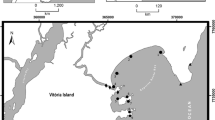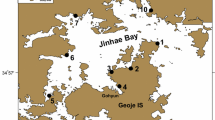Abstract
The imposex incidence and butyltin concentration i.e. tributyltin with its di- and mono-substituted metabolites were investigated in the muricid Bolinus brandaris sampled from two sites on the northern Tunisian coast (the Lagoon of Bizerta and the small Gulf of Tunis). Both populations had imposex, with stages of imposex development varying between VDS 1 and VDS 4.3. All imposex indices (imposex frequency (I %), female penis length, female vas deferens length, vas deferens sequence index, relative penis length index, and vas deferens length index) were significantly higher in snails from the Bizerta lagoon. Butyltins were detected in the whole tissues of both sexes from the two sites. TBT levels were higher in gastropods collected from the lagoon of Bizerta (12.65 ±1.48 ng Sn g − 1 dw in female and 15.21 ±1.13 ng Sn g − 1 dw in male) than in individuals from the Gulf of Tunis (10.71 ±1.26 ng Sn g − 1 dw in female and 11.65 ±1.63 ng Sn g − 1 dw in male), corroborating the data of imposex analysis. These results confirmed that B. brandaris could be used as a bioindicator species of butyltin pollution in the studied areas. In addition, this study provided baseline data that could serve for long-term monitoring of TBT pollution in Tunisia, since legislation to reduce the use of TBT-based antifouling paints has not been introduced yet.
Similar content being viewed by others
References
Abidli, S., Lahbib, Y., & Trigui-El Menif, N. (2009a). Effects of TBT on the imposex development, reproduction and mortality in Hexaplex trunculus (Gastropoda: Muricidae). Journal of the Marine Biological Association of the United Kingdom, 89, 139–146.
Abidli, S., Lahbib, Y., & Trigui-El Menif, N. (2009b). Imposex and genital tract malformations in Hexaplex trunculus and Bolinus brandaris collected in the Gulf of Tunis. Bulletin of Marine Science, 85, 11–25.
Axiak, V., Micallef, D., Muscat, J., Vella, A., & Mintoff, B. (2003). Imposex as a biomonitoring tool for marine pollution by tributyltin: Some further observations. Environment International, 28, 743–749.
Axiak, V., Vella, A. J., Micaleff, D., & Chircop, P. (1995). Imposex in Hexaplex trunculus (Gastropoda: Muricidae): First results from biomonitoring of tributyltin contamination in the Mediterranean. Marine Biology, 121, 685–691.
Bartolome, C. (1985). Contribution à l’étude de gastéropode Murex brandaris (Linné, 1758) dans le Golfe du Lion. DEA Thesis, Academie de Montpellier.
Blaber, S. J. M. (1970). The occurrence of penis-like outgrowth behind the right tentacle in spent females of Nucella lapillus. Proceedings of the Malacological Society of London, 39, 231–232.
Bryan, G. W., Gibbs, P. E., Burt, G. R., & Hummerstone, L. G. (1987). The effects of tributyltin (TBT) accumulation on adult dog-whelks, Nucella lapillus: Long-term field and laboratory experiments. Journal of the Marine Biological Association of the United Kingdom, 67, 525–544.
Chiavarini, S., Massanisso, P., Nicolai, P., Nobili, C., & Morabito, R. (2003). Butyltins concentration levels and imposex occurrence in snails from the Sicilian coasts. Chemosphere, 50, 311–319.
Couceiro, L., Díaz, J., Albaina, N., Barreiro, R., Irabien, J. A., & Ruiz, J. M. (2009). Imposex and gender-independent butyltin accumulation in the gastropod Nassarius reticulatus from the Cantabrian coast (N Atlantic Spain). Chemosphere, 76, 424–427.
Díez, S., Abalos, M., & Bayona, J. M. (2002). Organotin contamination in sediments from the Western Mediterranean enclosures following 10 years of TBT regulation. Water Research, 36, 905–918.
El Hamdani, A., Ferrer, J. M., & García Carrascosa, A. M. (1998). Imposex in prosobranch molluscs: An indicator of TBT pollution in the Valencian coast (Spain, Western Mediterranean). Cuadernos de Investigación Biológica, 20, 275–278.
Evans, S. M., Leksono, T., & McKinnell, P. D. (1995). Tributyltin pollution: A diminishing problem following legislation limiting the use of TBT-based anti-fouling paints. Marine Pollution Bulletin, 30, 14–21.
Garaventa, F., Centanni, E., Pellizzato, F., Faimali, M., Terlizzi, A., & Pavoni, B. (2007). Imposex and accumulation of organotin compounds in populations of Hexaplex trunculus (Gastropoda, Muricidae) from the Lagoon of Venice (Italy) and Istrian Coast (Croatia). Marine Pollution Bulletin, 54, 602–625.
Gibbs, P. E., & Bryan, G. W. (1986). Reproductive failure in populations of the dog-whelk, Nucella lapillus, caused by imposex undiced by tributyltin from antifouling paints. Journal of the Marine Biological Association of the United Kingdom, 66, 767–777.
Gibbs, P. E., Bryan, G. W., Pascoe, P. L. & Burt, G. R. (1987). The use of the dog-whelk, Nucella lapillus, as an indicator of tributyltin (TBT) contamination. Journal of the Marine Biological Association of the United Kingdom, 67, 507–523.
Horiguchi, T., Shiraishi, H., Shimizu, M., & Morita, M. (1997a). Imposex in sea snails, caused by organotin (tributyltin and triphenyltin) pollution in Japan: A survey. Applied Organometallic Chemistry, 11, 451–455.
Horiguchi, T., Shiraishi, H., Shimizu, M., & Morita, M. (1997b). Effects of triphenyltin chloride and five other organotin compounds on the development of imposex in the rock shell, Thais clavigera. Environmental Pollution, 195, 85–91.
Horiguchi, T., Shiraishi, H., Shimizu, M., Yamazaki, S., & Morita, M. (1995). Imposex in Japanese gastropods (Neogastropoda and Mesogastropoda): Effects of tributyltin and triphenyltin from antifouling paints. Marine Pollution Bulletin, 31, 402–405.
Lahbib, Y., Abidli, S., Chiffoleau, J. F., Averty, B., & Trigui El Menif, N. (2009). First record of butyltin body burden and imposex status in Hexaplex trunculus (L.) along the Tunisian coast. Journal of Environmental Monitoring, 11, 1253–1258.
Lahbib, Y., Abidli, S., Le Pennec, M., Flower, R., & Trigui El Menif, N. (2007). Morphological expression and different stages of imposex in Hexaplex trunculus (Neogastropoda: Muricidae) from Tunisian coasts. Cahiers de Biologie Marine, 48, 315–326.
Lahbib, Y., Abidli, S., & Trigui El Menif, N. (2008a). Imposex level and penis malformation in Hexaplex trunculus from the Tunisian coast. American Malacological Bulletin, 24, 79–89.
Lahbib, Y., Boumaiza, M., & Trigui El Menif, N. (2008b). Imposex expression in Hexaplex trunculus from the North Tunis Lake transplanted to Bizerta channel (Tunisia). Ecological Indicators, 8, 239–245.
Lemghich, I., & Benajiba, M. H. (2007). Survey of imposex in prosobranchs mollusks along the northern Mediterranean coast of Morocco. Ecological Indicators, 7, 209–214.
Martín, P., Sánchez, P., & Ramón, M. (1995). Population structure and exploitation of Bolinus brandaris (Mollusca: Gastropoda) off the Catalan coast (north-western Mediterranean). Fisheries Research, 23, 319–331.
Martoja, M., & Bouquegneau, M. (1988). Murex trunculus: Un nouveau cas de pseudo-hermaphrodisme chez un gasteropode prosobranche. Bulletin de la Société Royale des Sciences de Liège, 57, 45–58.
Morcillo, Y., & Porte, C. (1998). Monitoring of organotin compounds and their effects in marine molluscs. Trends in Analytical Chemistry, 17, 109–116.
Oehlmann, J. (1994). Imposex bei Muriciden (Gastropoda, Prosobranchia), eine ökotoxikologische Untersuchung zu TBT-Effekten. Göttingen: Cuvillier.
OSP (2008). Office of shipping and ports (p. 58). Annual Report, Tunisia.
Pellizzato, F., Centanni, E., Marin, M. G., Moschino, V., & Pavoni, B. (2004). Concentrations of organotin compounds and imposex in the gastropod Hexaplex trunculus from the Lagoon of Venice. Science of the Total Environment, 332, 89–100.
Poppe, G. T., & Goto, Y. (1991). European seashells. Polyplacophora, caudofoveata, solenogastra, gastropoda (Vol. 1). Wiesbaden: Verlag Christa Hemmen.
Ramón, M., & Amor, M. J. (2001). Increasing imposex in populations of Bolinus brandaris (Gastropoda: Muricidae) in the northwestern Mediterranean. Marine Environmental Research, 52, 463–475.
Rilov, G., Gasith, A., Evans, S. M., & Benayahu, Y. (2000). Unregulated use of TBT-based antifouling paints in Israel (eastern Mediterranean): High contamination and imposex levels in two species of marine gastropods. Marine Ecology Progress Series, 192, 229–238.
Santos, M. M., Reis-Henriques, M. A., Vieira, M. N., & Solé, M. (2006). Triphenyltin and tributyltin, single and in combination, promote imposex in the gastropod Bolinus brandaris. Ecotoxicology and Environmental Safety, 64, 155–162.
Shi, H. H., Huang, C. J., Zhu, S. X., Yu, X. J., & Xie, W. Y. (2005). Generalized system of imposex and reproductive failure in female gastropods of coastal waters of mainland China. Marine Ecology Progress Series, 304, 179–189.
Smith, B. S. (1971). Sexuality in the American mud snail Nassarius obsoletus Say. Proceedings of the Malacological Society of London, 39, 377–378.
Solé, M., Morcillo, Y., & Porte, C. (1998). Imposex in the commercial snail Bolinus brandaris in the northwestern Mediterranean. Environmental Pollution, 99, 241–246.
Stewart, C., de Mora, S. J., Jones, M. R. L., & Miller, M. C. (1992). Imposex in New Zealand neogastropods. Marine Pollution Bulletin, 24, 204–209.
Stroben, E., Oehlmann, J., & Fioroni, P. (1992). The morphological expression of imposex in Hinia reticulata (Gastropoda: Buccinidae): A potential indicator of tributyltin pollution. Marine Biology, 113, 625–636.
Terlizzi, A., Fraschetti, S., Gianguzza, P., Faimali, M., & Boero, F. (2001). Environmental impact of antifouling technologies: State of art and perspectives. Aquatic Conservation. Marine and Freshwater Ecosystems, 11, 311–317.
Terlizzi, A., Geraci, S., & Gibbs, P. E. (1999). Tributyltin (TBT)-induced imposex in the Neogastropod Hexaplex trunculus in Italian coastal waters: Morphological aspects and ecological implications. Italian Journal of Zoology, 66, 141–146.
Terlizzi, A., Geraci, S., & Minganti, V. (1998). Tributyltin (TBT) pollution in the coastal waters of Italy as indicated by imposex in Hexaplex trunculus (Gastropoda: Muricidae). Marine Pollution Bulletin, 36, 749–752.
Trigui El Menif, N., Lahbib, Y., Le Pennec, M., Flower, R., & Boumaiza, M. (2006). Intensity of the imposex phenomenon - impact on growth and fecundity in Hexaplex trunculus (Mollusca: Gastropoda) collected in Bizerta lagoon and channel (Tunisia). Cahiers de Biologie Marine, 47, 1–11.
Vasconcelos, P., Carvalho, S., Castro, M., & Gaspar, M. B. (2008). The artisanal fishery for muricid gastropods (banded murex and purple dye murex) in the Ria Formosa lagoon (Algarve coast, southern Portugal). Scientia Marina, 72, 287–298.
Author information
Authors and Affiliations
Corresponding author
Rights and permissions
About this article
Cite this article
Abidli, S., Lahbib, Y. & Trigui El Menif, N. Imposex and butyltin concentrations in Bolinus brandaris (Gastropoda: Muricidae) from the northern Tunisian coast. Environ Monit Assess 177, 375–384 (2011). https://doi.org/10.1007/s10661-010-1640-z
Received:
Accepted:
Published:
Issue Date:
DOI: https://doi.org/10.1007/s10661-010-1640-z




